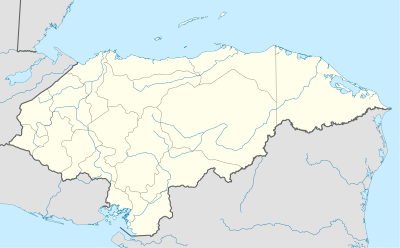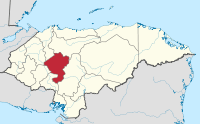Siguatepeque, Comayagua
| Siguatepeque | |
|---|---|
| Municipality | |
 Siguatepeque | |
| Coordinates: 14°36′N 87°50′W / 14.600°N 87.833°W | |
| Country |
|
| Departament | Comayagua |
| Founded | 1861 |
| Area | |
| • Total | 398 km2 (154 sq mi) |
| Population (2015) | |
| • Total | 99,164 |
| • Density | 250/km2 (650/sq mi) |
Siguatepeque (Spanish pronunciation: [siɣwateˈpeke]) is a town and municipality in the Honduran department of Comayagua.
Siguatepeque, located in the central mountains of Honduras (population 75,000) is green and colourful, and can be described as a garden town. The region, with its rural flavour, is primarily dedicated to farm and forest enterprises. The National School of Forestry Science (ESNACIFOR) provides training for students from all of Latin America. Building on its natural attractions and beauty, the region has opened itself up to eco-tourism, with Siguatepeque functioning as a base for visitors making trips to destinations within Central Honduras. The town is 1100 metres above sea level.
There are three seasons:
- during the wet and fairly cool season between May and November, enough rain falls in the area to ensure luxurious vegetation, while it escapes the excessive humidity of the far hotter and wetter lowland areas.
- a cooler interlude from November to February provides temperatures occasionally down to 8 °C (40 °F) as cold fronts enter from the north.
- the dry season is February to May with temperatures achieving a pleasantly warm peak of 32 °C (95 °F). Cool winds flow down from the local Calenterique forest and from the Cordillera Montecillos, a biological reserve on the southern edge of the valley.
Even in the hot season air conditioning is unnecessary, with a fan almost always being enough. In the winter heating is rarely needed.
History
Founded by the Spanish in 1689 as a religious centre for retreats and monastic training, the population of the town grew through the intermarriage of colonists, the indigenous Lencas and the Mexican Nahuatl immigrants. The name means ‘town of beautiful women’ in the Nahuatl Mexican dialect. In 1861 the town became a municipality in its own right, and a city in 1926.
Amenities
The town is at the centre of a regional vegetable and fruit production area, ensuring a year-round supply of produce. The town has good shopping facilities, and the stores are filled with local and Central American products, as well as imported items. Due to the small size of the town centre, the stores are easy to visit on foot.
Amenities in Siguatepeque include a large swimming pool, an acupuncture centre, a private hospital, two cinemas and numerous restaurants. The town offers several bilingual schools up to college level, as well as the new Catholic University.
All the major banks are represented in the town centre. Banco Atlantida has a branch along the main intercity highway in Granja D’Elia. The main Banco Atlantida office in the town centre handles Visa transactions. Banco Occidente handles Western Union money transfers.
Travel
Located almost exactly halfway between Honduras' two largest cities of San Pedro Sula and Tegucigalpa, Siguatepeque is easy to reach – the town is two hours travel from Tegucigalpa or San Pedro Sula. It is a major stopping point for rest and refreshment for Honduran and international inter-city traffic, which has spurred a proliferation of highway restaurants and gas stations.
The easiest and cheapest way to travel to and from Siguatepeque is by bus. There are many options.
From Tegucigalpa regional bus services serving San Pedro Sula, Santa Barbara, El Progreso, Tela, Santa Rosa de Copan, La Esperanza, La Ceiba, or any other town beyond Siguatepeque to the North.
Some of the companies serving smaller towns tend to make frequent stops to pick up and drop off passengers, making the journey longer, though often more interesting. Many travellers prefer to use the direct bus services between San Pedro Sula and Tegucigalpa; the three services are Empresa Saenz, Empresa El Rey and Hedman Alas .
To catch any of the regional services for a journey out of Siguatepeque towards Tegucigalpa or Comayagua, a taxi can be taken to the bus shelter on the main highway, next to the pedestrian bridge. On the opposite side of the road is another bus shelter (next to the Texaco gas station) that serves passengers travelling to San Pedro and destinations north and west.
Other options for travel to or from Siguatepeque are the locally based direct bus services. The direct bus service to/from Tegucigalpa is called Empresas Unidas (located on the eastern side of San Pablo square) Their Tegucigalpa terminal is in the Comayaguela sector of the city. The direct service to and from San Pedro Sula is Empresas Etul and its buses leave from the bus station one block west of San Pablo square. This bus station is also used for other local services in the area.
To travel to La Esperanza buses go from the turnoff about 4 km from town centre, next to the new Texaco Service Centre. Buses from here will travel onwards to the Lenca highlands. Five kilometres further along this route is El Porvenir village, which specialises in clay handicrafts.
Medical
The Evangelical Hospital attracts clients from throughout Honduras. Dozens of private general and specialist clinics operate here, in particular El Carmen Medical Center, Hospital Las Mercedes, as well as dental clinics. About 15 pharmacies serve the locality.
For alternative therapies, the Hospital de Acupuntura (located in Barrio Macaruya) offers acupuncture, dentistry, herbal medicines, sauna and massage.
For a town its size the city has prime medical attention making it a medical destination for the country and region.
